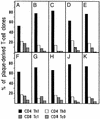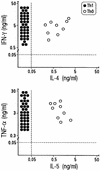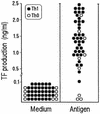T helper type 1 lymphocytes drive inflammation in human atherosclerotic lesions
- PMID: 12740434
- PMCID: PMC164503
- DOI: 10.1073/pnas.1135726100
T helper type 1 lymphocytes drive inflammation in human atherosclerotic lesions
Abstract
Atherosclerotic lesions are infiltrated by macrophages and T lymphocytes, potentially reactive to pathogens. We studied in vivo activated T lymphocytes that infiltrate atherosclerotic plaques of Helicobacter pylori-infected patients with or without anti-Chlamydia pneumoniae antibodies. In all atherosclerotic lesions, T helper type 1 (Th1) cells were predominant. C. pneumoniae-specific T cells were detected only in the plaques of anti-C. pneumoniae seropositive patients, whereas H. pylori-specific T cells were found in the gastric mucosa but not in the plaques of the same patients. Plaque-derived Th1 cells expressed cytotoxicity, proapoptotic activity, and help for monocyte tissue factor production. Although multifactorial, atherosclerosis can be regarded as a Th1-driven immunopathological condition.
Figures





Similar articles
-
Detection of Chlamydia pneumoniae but not of Helicobacter pylori in symptomatic atherosclerotic carotids associated with enhanced serum antibodies, inflammation and apoptosis rate.Atherosclerosis. 2003 May;168(1):153-62. doi: 10.1016/s0021-9150(03)00085-6. Atherosclerosis. 2003. PMID: 12732399
-
Detection of Chlamydia pneumoniae but not Helicobacter pylori in atherosclerotic plaques of aortic aneurysms.J Clin Microbiol. 1996 Nov;34(11):2766-9. doi: 10.1128/jcm.34.11.2766-2769.1996. J Clin Microbiol. 1996. PMID: 8897180 Free PMC article.
-
Detection of Helicobacter pylori and Chlamydia pneumoniae DNA in human coronary arteries and evaluation of the results with serologic evidence of inflammation.Saudi Med J. 2005 Jul;26(7):1068-74. Saudi Med J. 2005. PMID: 16047055
-
Atherosclerosis, inflammation, and infection.J Pathol. 2000 Feb;190(3):237-43. doi: 10.1002/(SICI)1096-9896(200002)190:3<237::AID-PATH541>3.0.CO;2-N. J Pathol. 2000. PMID: 10685058 Review.
-
Molecular mimicry in atherosclerosis: a role for heat shock proteins in immunisation.Atherosclerosis. 2003 Apr;167(2):177-85. doi: 10.1016/s0021-9150(02)00301-5. Atherosclerosis. 2003. PMID: 12818399 Review.
Cited by
-
Role of Helicobacter pylori infection in pathogenesis of atherosclerosis.World J Cardiol. 2015 Mar 26;7(3):134-43. doi: 10.4330/wjc.v7.i3.134. World J Cardiol. 2015. PMID: 25810813 Free PMC article. Review.
-
Piceatannol induces regulatory T cells and modulates the inflammatory response and adipogenesis.Biomed Pharmacother. 2023 May;161:114514. doi: 10.1016/j.biopha.2023.114514. Epub 2023 Mar 13. Biomed Pharmacother. 2023. PMID: 36921534 Free PMC article.
-
Persistent Chlamydia pneumoniae infection of cardiomyocytes is correlated with fatal myocardial infarction.Am J Pathol. 2007 Jan;170(1):33-42. doi: 10.2353/ajpath.2007.051353. Am J Pathol. 2007. PMID: 17200180 Free PMC article.
-
Cannabinoids and atherosclerotic coronary heart disease.Clin Cardiol. 2012 Jun;35(6):329-35. doi: 10.1002/clc.21962. Epub 2012 Jan 25. Clin Cardiol. 2012. PMID: 22278660 Free PMC article. Review.
-
Functional and homeostatic defects of regulatory T cells in patients with coronary artery disease.J Intern Med. 2016 Jan;279(1):63-77. doi: 10.1111/joim.12398. Epub 2015 Aug 11. J Intern Med. 2016. PMID: 26260103 Free PMC article.
References
-
- Ross, R. (1999) N. Engl. J. Med. 340, 115–126. - PubMed
-
- Epstein, S. E., Zhou, Y. F. & Zhu, J. (1999) Circulation 100, 20–28. - PubMed
-
- Jonasson, L., Holm, J., Skalli, O., Bondjers, G. & Hansson, G. K. (1986) Arteriosclerosis 6, 131–138. - PubMed
-
- Hansson, G. K., Jonasson, L., Seifert, P. S. & Stemme, S. (1989) Arteriosclerosis 9, 567–578. - PubMed
-
- Espinola-Klein, C., Rupprecht, H. J., Blankenberg, S., Bickel, C., Kopp, H., Rippin, G., Victor, A., Hafner, G., Schlumberger, W. & Meyer, J. (2002) Circulation 105, 15–21. - PubMed
Publication types
MeSH terms
Substances
LinkOut - more resources
Full Text Sources

